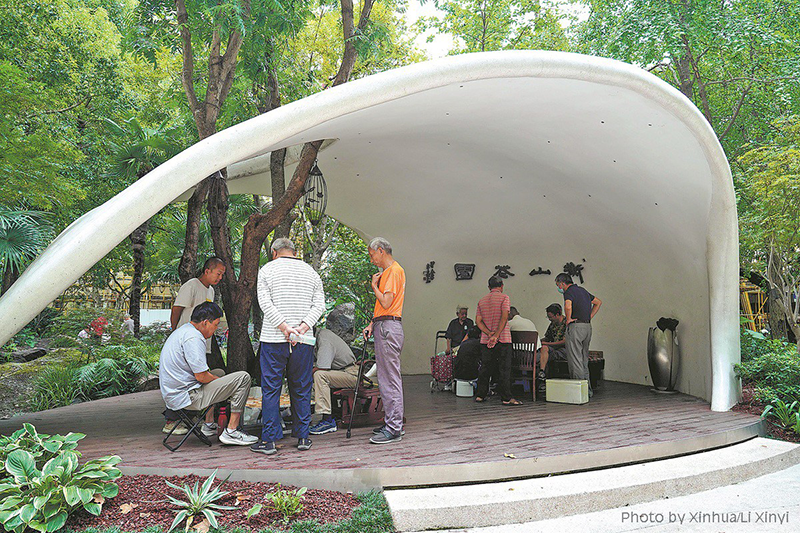



▲ Residents relax at a pocket park in Shanghai's Xujianhui district. LI XINYI/XINHUA. [Xinhua/ Li Xinyi]
3. Design and Construction.
3.1 General requirement.
(1) Meet the needs of the surrounding population.
Pocket park designs should fully consider the age structure and actual usage needs of the surrounding population. For parks near residential areas, it is appropriate to focus on designing spaces for children's play and activities for the elderly. For parks near public service facilities, the priority should be to meet public leisure and convenient access needs. For parks near primary and secondary schools and kindergartens, child-friendly functions should be included, and facilities like public toilets and waiting areas for parents should be provided, considering the characteristics of the surrounding environment.
(2) Create an open and shared park environment.
The layout of pocket parks should be organically integrated with the construction of the urban slow traffic system, making full use of the greenway system to connect green activity spaces. Strengthen the connections with urban bus stops, pedestrian routes, and entrances and exits of surrounding buildings to facilitate public access.
(3) Focus on simple and rational spatial layout.
According to the scale of the site, location, and surrounding environmental conditions, scientifically, the proportion of green space and hard paving area should be determined by reasonably estimating the number of users. Delineate the functional zoning, distinguish between dynamic and static spaces, and layout various activity areas. Reasonably set up multifunctional areas to increase the utilization rate of space. The layout should be simple and smooth, convenient for public use.
(4) Ensure a safe and comfortable environment.
The design and facilities of activity venues should consider the needs of the elderly, children, and people with disabilities, and strengthen barrier-free design. Attention should be given to shade in summer and lighting at night. Avoid nearby safety hazards and interference factors, and adopt necessary measures such as green insulated belt or facility protection to reduce environmental disturbances.
(5) Showcase distinctive themes of each venue.
Emphasize the discovery of cultural characteristics of the site and surrounding areas, rationally determine and express the park’s cultural theme to enhance its cultural and artistic charm. If there are historic remains within the site, the protection, interpretation, presentation, and utilization of the historic remains should be strengthened.
3.2 Activity venues.
(1) Rest and social activity venues.
Design and construct the venues according to the principles of “appropriate scale, multifunctional use, and flexible forms”. Create suitable spatial forms based on usage needs and site conditions to meet various activity functions, avoiding overly large and unsuitable scales.
Benches, pergolas, and other rest facilities should focus on safety and comfort. Pergolas should consider shade and rain protection, and wheelchair spaces should be spared next to benches.
(2) Children’s activity venues.
Choose sunny and well-ventilated locations, the site should have no less than half of the activity area outside the shadow of buildings, and the site should be selected in locations shielded from winter winds by buildings or structures.
Children's activity venues should take into account the characteristics of different age groups, appropriately organize different zones, and ensure visual transparency in spatial design. Facilities should be novel, lively, and close to nature, with rich and bright colors that meet children’s nature. The materials of children’s game facilities and equipment should be environmentally friendly and safe.
Non-toxic, thorn-free, colorful, and various vegetation should be planted in and around children’s activity venues to stimulate their interest and knowledge of nature. Mini-vegetable gardens, play corners, graffiti walls and other natural experience venues and aesthetic spaces can be set up.
Venues with large elevation differences can incorporate grass steps, viewing platforms, and recreation facilities suitable for neighborly interaction to effectively manage elevation changes and improve space utilization.
(3) Sports and fitness venues.
These include health and fitness venues and sports activity venues. Sports and fitness venues should not overlap with other activity venues or main park paths to ensure safety.
Health and fitness venues should be located in easily accessible places with appropriate tree shade. The choice of fitness equipment should consider various types, including strength, endurance, flexibility, and agility.
Sports venues mainly consist of small multifunctional sports grounds, including table tennis tables, badminton courts, and non-standard basketball courts. These venues should be located away from nearby residences and office buildings, with buffer facilities such as protective barriers or green insulated belt as necessary to reduce interference and ensure safety. When sports venues are adjacent to children’s or elderly people’s activity venues, safety buffer space or isolation measures should be set up to prevent collisions.
Benches and storage facilities should be available around sports venues, and supporting facilities such as direct drinking water should be installed where possible.
Source:
<https://www.gov.cn/zhengce/zhengceku/202406/content_6959879.htm>
https://mp.weixin.qq.com/s/7rDoAKkk00qa5a5M86HFCA